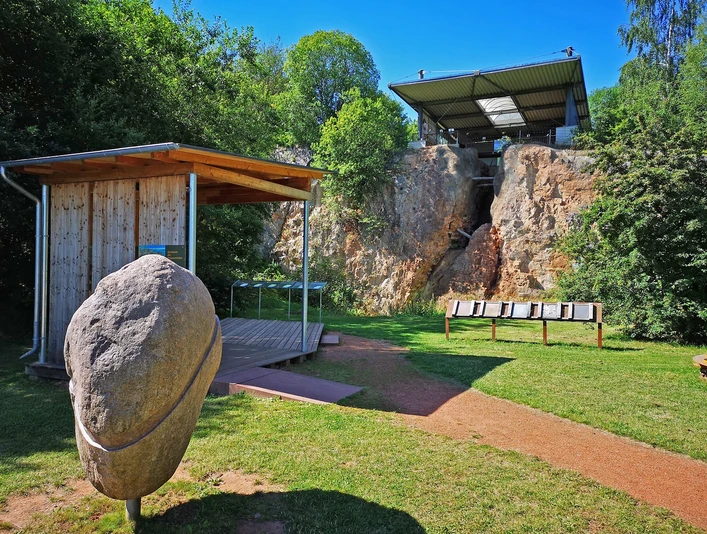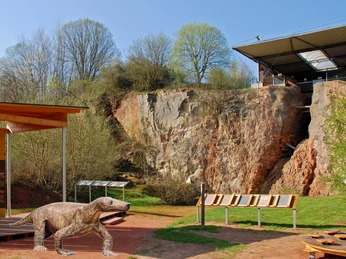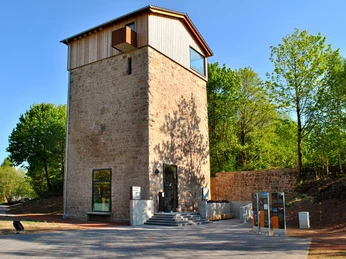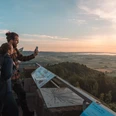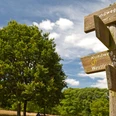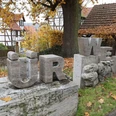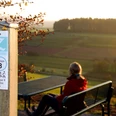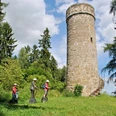The fossil site was discovered in the mid-1960s by the geologist and local historian Dr. Jens Kulick. It was only in 1988 that a lower jaw fragment could be attributed to the genus "Procynosuchus," a mammal-like reptile that lived around 250 million years ago during the upper Permian period. It is colloquially referred to as the "Korbach Dachshund."
Between 1990 and 1998, the State Museum of Natural History in Karlsruhe conducted several excavation campaigns, recovering approximately 2,500 analyzable bone fragments. The Korbach finds provided the first evidence of Procynosuchus on the northern hemisphere of the Earth. This is considered an indication that at that time, all the land masses on Earth were united in the supercontinent Pangaea. Alongside the World Heritage Site Grube Messel, the Korbacher Spalte fossil site is the most important paleontological site in Hessen.
Augmented Reality - Interactivity at the Korbacher Spalte!
Using Augmented Reality, the Korbacher Spalte is enhanced with a digital and interactive highlight. Bring long-gone eras and creatures back to life, making your visit to the Korbacher Spalte an experience for the whole family!
All you need is your smartphone or tablet to scan the QR codes in the information pavilion located at the Korbacher Spalte. From there, you can choose to view the "Korbacher Dachshund" in a 3D simulation or witness the formation of the Korbacher Spalte in a 2D simulation up close.
Formation of the fossil fissure:
During the Zechstein era around 260 million years ago, a large inland sea extended across northern Central Europe. It was supplied with seawater from the open ocean in several phases and evaporated due to the desert-like climate, leaving typical rock formations of limestone, sulfates (gypsum and anhydrite), and salts.
At that time, the Korbach area was situated in the western coastal region of this Zechstein sea on the eastern edge of the present-day Rhenish Massif. During the first advance of the sea, the coast was lined with a vegetation belt that provided favorable living conditions and served as a food source for the land-dwelling reptiles.
As the sea retreated during the initial phase of evaporation in the increasingly hot and dry climate, vegetation decreased, depriving the reptiles of their food source, and the herbivores migrated away. Along with them, the carnivores disappeared. Many animals died, and their skeletons were embedded in the sands of the desert-like landscape at the edge of the mountain.
Some time later, during rainy periods, the sediment cover, no longer protected by any vegetation, was washed down, carrying the preserved skeletons with it. The sediment, along with the crushed bones and bone fragments due to transport, filled the fissures that had formed in the limestone, probably due to mechanical events like earthquakes.
Shortly after, more erosion material from the mountains covered the landscape before the Zechstein sea advanced multiple times into the Korbach area, finally sealing the fossil-filled fissure with new limestone deposits.
Access Information:
The quarry with the information pavilion is freely accessible. The protective shelter over the Korbacher Spalte can only be visited as part of guided tours:
April-October, Sunday 11:15 AM July+August, additionally Monday 4:30 PM The tours cost €4 for adults and €2 for children and teenagers. Children up to 6 years old and guests with the MeineCardPlus have free admission.
The entry to the neighboring GeoFoyer Kalkturm Korbach is €1 per person. Opening hours: March-October, Tuesday-Sunday+Holidays 11:00 AM - 4:30 PM; November-February, Tuesday-Friday 2:00 PM - 4:30 PM, Saturday+Sunday+Holidays 11:00 AM - 4:30 PM.
Good to know
Payment methods
Directions & Parking facilities
Parking facilities directly on site.
Social Media
Documents
More information
Mit der MeineCardPlus erlebst Du als Gast der GrimmHeimat NordHessen während deines Aufenthaltes rund 160 Attraktionen kostenlos und es ist Dein Ticket für die Freie Fahrt mit Bussen und Bahnen des Nordhessischen Verkehrsverbundes.
Die MeineCardPlus gibt es bei über 140 teilnehmenden Gastgeberinnen und Gastgebern.
Author
Korbach-Information
Organization
License (master data)
Nearby
